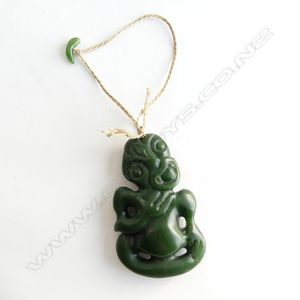
Contemporary Maori Carved Pounamu Hei Tiki with Kawakawa Nephrite
A contemporary Maori carved pounamu hei tiki, ' B ' type, head turned to left shoulder, three finger hand to chest and thigh. Of good depth. Kawakawa nephrite, height 11 cm

Female Maori pounamu hei tiki, pre-European, type II pendant
A Maori pre-European pounamu hei tiki, type II, of female form, well carved with head turned to the left shoulder, displays small recessed ring eyes, chin and ear projections, the counter sunk suspension hole dominantly drilled from the reverse one hand…
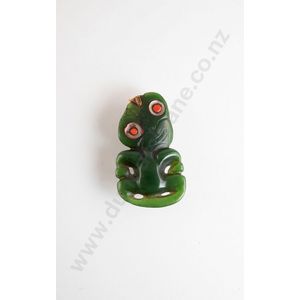
18th Century Kahurangi Pounamu Hei Tiki
A superb 18th century hei tiki, type I form with both hands to thighs, carved in highly prized Kahurangi pounamu. Facial features finely carved but worn, inlaid paua eyes and red ceiling wax embellishment. Some natural scaring to the back of the head.…
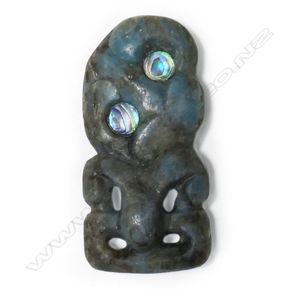
Blue Pounamu Hei Tiki with Paua Inset Eyes
A very small pounamu hei tiki, of unusual blue toned stone, with head tilted, chin to left shoulder, paua inset eyes, flexed stance with hands to thighs, height 5.5 cm
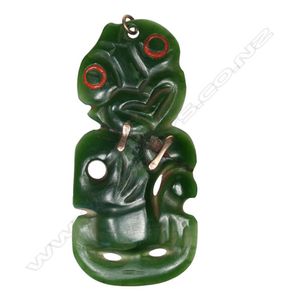
Gold-repaired Maori Hei Tiki Pendant
A 19th century pounamu Maori hei tiki with gold repairs, with chin to left shoulder., the right hand to chest and left to thigh, cracked through and with two rose gold pinned bar repairs, length 11 cm.

Pounamu Heitiki with Red Sealing Wax
A pounamu heitiki, Aotearoa, head tilted to the left shoulder, hands on thighs, four incisions on each hand for fingers. Knees bent and feet together, with two diamond-shaped incisions for genitals. With red sealing wax around the circular eyes. With a…
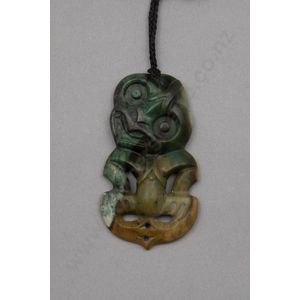
Kawakawa Pounamu Hei Tiki with Marsden Inclusions
Pounamu hei tiki by Des Baker, Kawakawa variety stone with Marsden inclusions. Well carved in the classical type I style pierced through the top of the head for suspension. 10 cm length

Inanga Pounamu Hei Tiki by Alan Brown
A pounamu hei tiki by Alan brown (ngati Ruaka), a superbly carved 20th century example of the classic type I hei tiki form made in chatoyant inanga variety stone from the Arahura river. The head displays a rightward orientation with deeply recessed eyes…
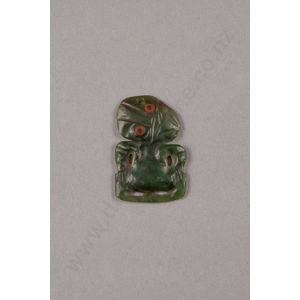
Bowenite Hei Tiki Pendant with Red Eyes
Small pounamu hei tiki, type I form carved in Bowenite variety stone, eyes embellished with red ceiling wax. Countersunk suspension hole at the top. 5 cm length.

Polished Pounamu Hei Tiki with Inlaid Paua Eyes
Pounamu hei tiki by Scott Parker (ngati Tama), a good 20th century example of the classic hei tiki type I style. Superbly carved in highly polished Kawakawa variety stone with both hands to the thighs and head tilted to the right with inlaid serrated paua…

Ngati Tama Pounamu Hei Tiki by Scott Parker
Pounamu hei tiki by Scott Parker (ngati Tama), a good 20th century hei tiki carved in the classic type I style in the inanga stone variety. The head displays a rightward orientation with inlaid serrated paua eyes upon a delineated neck with three ribs and…
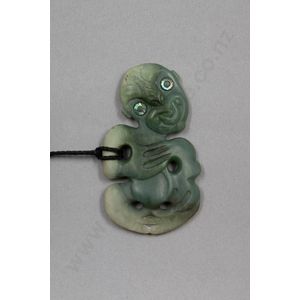
Inanga Pounamu Hei Tiki by Scott Parker
Pounamu hei tiki by Scott Parker (ngati Tama), a rarer type II style hei tiki carved in inanga variety stone. The head shows a rightward orientation with chin and ear projections and the eyes are inlaid with serrated paua shell. The right-hand displays…
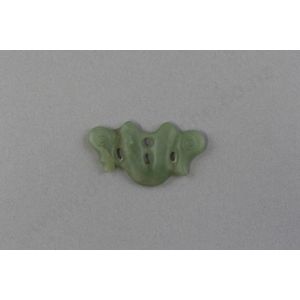
Antique Pounamu Pekapeka Pendant with Provenance
19th century pounamu pekapeka, polished tangiwai (bowenite) variety stone. Recessed eyes. Provenance: belonged to Annie Shasky (nee Turnball) the current owners great grandmother. Most likely given to Annie when her husband George Shasky was gifted his…
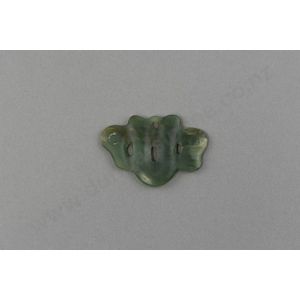
Polished Pounamu Pekapeka with Provenance
19th century pounamu pekapeka, polished tangiwai (bowenite) variety stone showing the grain. Recessed eyes. Provenance: belonged to Annie Shasky (nee Turnball) the current owner's great grandmother. Most likely given to Annie when her husband George…

Inanga Hei Tiki Pendant
19th century pounamu hei tiki, a type I hei tiki carved in inanga variety stone with pale inclusions across the torso, left side, and facial area. Suspension hole at centre top. 8.5 cm length.
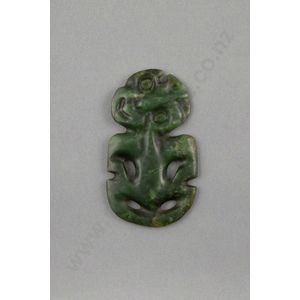
18th Century Kawakawa Hei Tiki Pendant
Early 18th century pounamu hei tiki, a rare stone tooled hei tiki carved in the classic type I form made in Kawakawa variety stone. This hei tiki displays two countersunk suspension holes indicating its significant age. The head is oriented to the left…
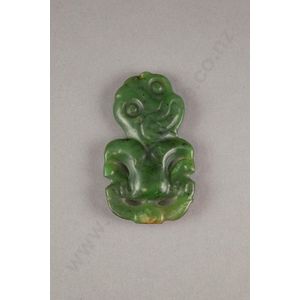
Kawakawa Hei Tiki Pendant, 19th Century
19th century pounamu hei tiki, type I carved in kawakawa variety stone. Head oriented rightwards with deeply recessed eyes and mouth displaying two teeth. Three-fingered hands to thighs. Countersunk suspension hole to the top of head. 10 cm length.
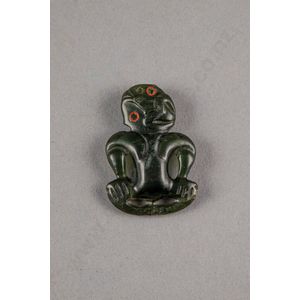
Tangiwai Hei Tiki Pendant
19th century small pounamu hei tiki, Tangiwai (bowenite) variety stone. Type I form with red ceiling wax embellishment to eyes, three-fingered hands to thighs. 6 cm length. Y number pending.
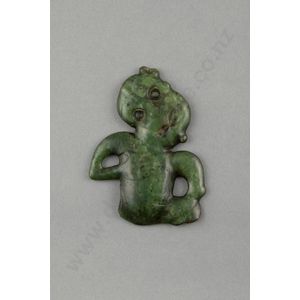
Kawakawa Pounamu Hei Tiki with Inanga Inclusions
Pre-European pounamu hei tiki, Kawakawa variety stone with inanga inclusions, type II form with fine facial details showing some ware, three-fingered hands with thumbs to the chest and thigh. Suspension hole on outstanding lug. Female. Right thigh and…
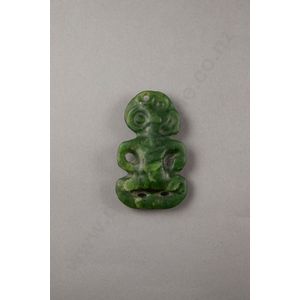
Pre-European Pounamu Hei Tiki from Dame Jenny Gibbs Collection
Pre-European pounamu hei tiki, type I form carved in Kawakawa variety stone with pale inclusions to the body. Countersunk suspension hole at the top of the head. Provenance: Dame Jenny Gibbs collection, 10 cm length.
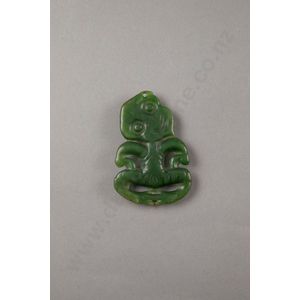
Translucent Kahurangi Hei Tiki Pendant
Contact period pounamu hei tiki, finely carved in the type I form in translucent Kahurangi variety stone, finely carved facial features with a clearly defined heart-shaped mouth displaying tongue and teeth. Female. Suspension hole at the top of the head.…
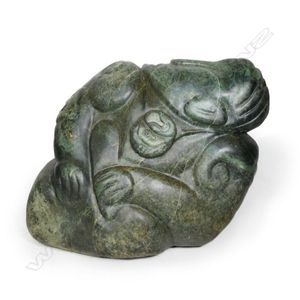
Maori Pounamu Hei Tiki Figure with Mere
A large Maori figure carved pounamu boulder, the stylised figure wearing a hei tiki, with hands to front, holding a mere, soft edged carving. Dark tone with pale inclusions and golden tan highlights. 64 cm x 38 cm x 46 cm. Approximately 160kgs.
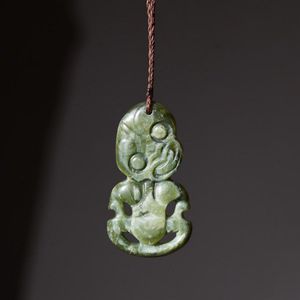
Orthodox Bowenite Pounamu Hei Tiki Pendant
A Bowenite pounamu hei tiki, Orthodox form with hands clasped to thighs. Woven lanyard through suspension hole. Height 11 cm, width 6 cm
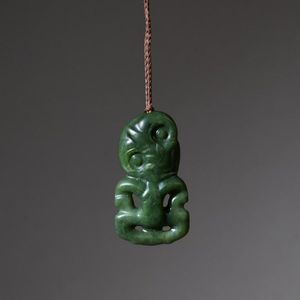
Kahurangi Stone Hei Tiki Pendant
A pounamu hei tiki in Kahurangi stone, Orthodox form with hands clasped to thighs. Suspension hole with oven lanyard. Height 8 cm, width 4.5 cm
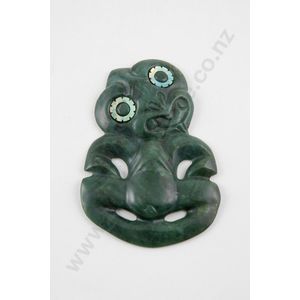
Ngati Ruaka Pounamu Hei-Tiki Pendant, 20th Century
Pounamu hei-tiki by Alan brown (ngati Ruaka), finely carved 20th century example. Kawakawa variety stone with titled head and with broad shoulders and arms to thighs. Cut and serrated paua shell eyes, pierced to the back of the head for suspension, 12 x 9…
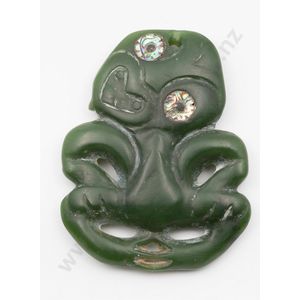
Paua-eyed Hei Tiki from Arthur Beau Palmer Collection
A good pounamu hei tiki, contact period with head tilted to right shoulder and with cut paua shell eyes and hourglass suspension hole, modelled with lightly delineated three fingered hands placed to thighs, 10 x 8 cm. Provenance; Arthur Beau Palmer…
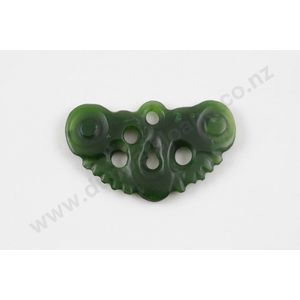
Rare Pounamu Pekapeka Pendant with Manaia Heads
Pounamu pekapeka (nephrite pendant), finely carved from Kawakawa variety pounamu, with cut circular eyes and asymmetrical countersunk suspension hole, pekapeka are named after the small native New Zealand bat which they are said to resemble in appearance.…
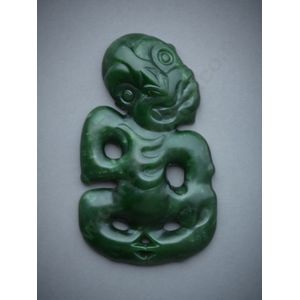
Kawakawa Pounamu Hei-Tiki: Finely Carved 20th Century Example
Pounamu hei-tiki, a finely carved 20th century example. Kawakawa variety pounamu with a titled head and pointed chin. The shoulders tilt diagonally with one broad strongly delineated three figured hand on the chest and a lightly delineated hand on the…
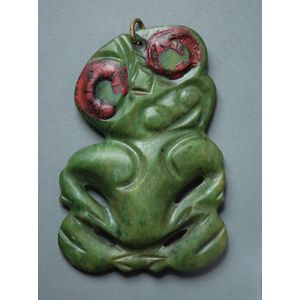
Goldie's Hei-Tiki with Provenance from Ngaheke Perira Te Kahikura
An important 19th century pounamu hei-tiki from the collection of Charles Frederick Goldie, light green inanga type variety with tilted head and lightly delineated hands placed on the thighs. The circular eyes with applied red sealing wax. Pierced through…
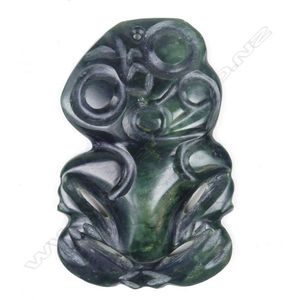
1900 Maori Pounamu Hei Tiki Pendant
A circa 1900 Maori pounamu hei tiki, chin to left shoulder, hands to thighs, dark green tone with mid green highlights. Height 9.3 cm. Being assessed for registration.
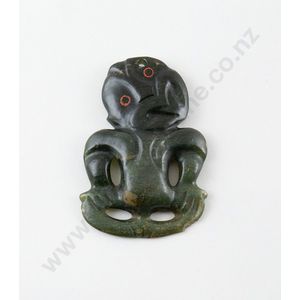
Greenstone Tiki, 20th Century
20th century greenstone tiki, traditional form with both hand on thighs, (chip to bottom left), 9.5 cm height
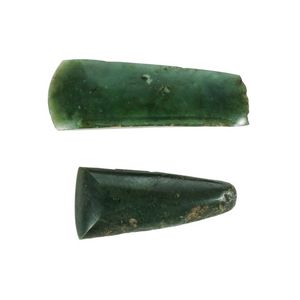
Maori Hei-tiki: Nephrite and Greenstone Varieties
Two various Maori Hei-tiki. Old nephrite tiki, with broken top. Grooved to one side. Also greenstone older tiki, age patina. Length 10 cm (nephrite)
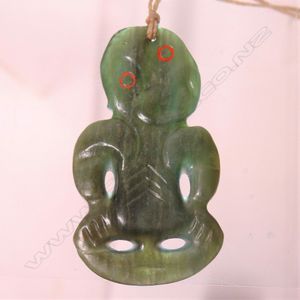
Rare Maori Bowenite Pounamu Hei Tiki with Provenance
A 19th/20th century Maori rare bowenite pounamu hei tiki, red sealing wax to the eyes, hands clasped to thighs, height 86 cm. Provenance: 'Given to owner by Tom Sterland in 1958-9. Tom Sterland born Stewart Island 1896-7. As a lad he helped sealers and…
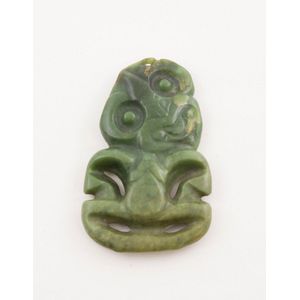
19th Century Maori Greenstone Hei Tiki with Stand
A pre 19th century carved Maori greenstone hei tiki, head tilted to left shoulder, both arms to thighs. Hourglass form suspension hole. With stand, height 10 cm.
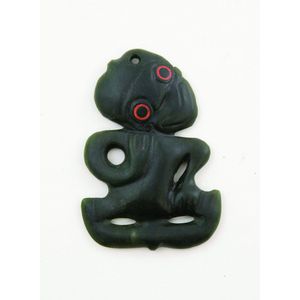
Greenstone Hei Tiki with Red Sealing Wax Eyes
An 19th century or early 20th century greenstone hei tiki, red sealing wax eyes, peaked head, one hand to neck, the other to thigh. Head tilted to left shoulder, height 9.5 cm.
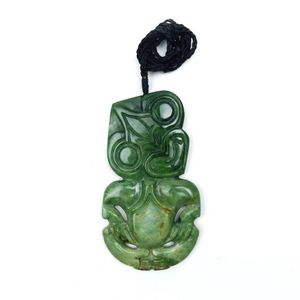
Ring-Eyed Pounamu Hei Tiki: Contemporary Traditional Style
A contemporary pounamu hei tiki of traditional style with ring eyes, head tilted, hands to thighs, height 12 cm
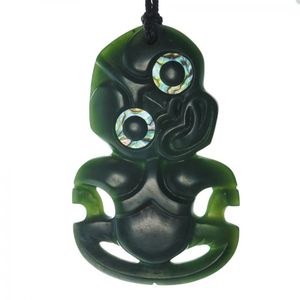
Superfine Kahurangi Pounamu Hei Tiki
A superfine Kahurangi pounamu hei tiki, meticulously carved with head tilted to the left, wide open paua inlaid eyes, flared nostrils, heart-shaped mouth with tongue out and hands clasped to thighs. Suspension hole with lanyard above the left eye. Deep…
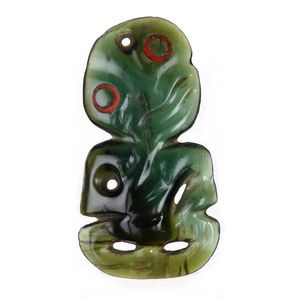
Rare Bowenite Maori Hei Tiki Pendant
An uncommon 19th century Maori pounamu hei tiki, chin turned to the left, remnants of red sealing wax to eyes, right hand to abdomen, left hand to thigh. Height 9.5 cm. Note: in the uncommon Bowenite variety of pounamu, displaying high translucency and of…
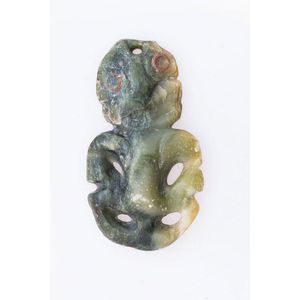
19th Century Pounamu Hei Tiki with Red Seal Eyes
A 19th century pounamu hei tiki. Red sealing wax to eyes, hour glass form suspension hole. Worn head to left, arms to thighs. Large protruding stomach. Height 11 cm. Provenance: Purchased Dunbar Sloane Ltd, lot 52, December 1972. 10.9 cm

Pre-European Maori Pounamu Hei Tiki Pendant
A pre-European Maori pounamu hei tiki, of small rounded rectangular form, the suspension hole with heavy countersinking to the reverse flanked by the eyes, flat topped head, hands to thighs, mid green tone, height 5.2 cm. Registered Y20956
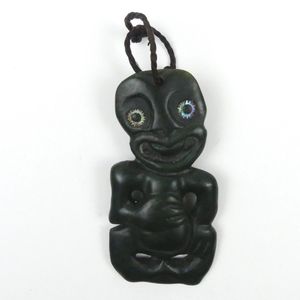
Taranaki-style Pounamu Hei Tiki with Paua Shell Inlay
A pounamu hei tiki, in Taranaki style, with upright head, ring eyes inlaid with serrated edged paua shell, standing in flexed stance, one had to chest above a corpulent belly, one hand to thigh, height 13 cm
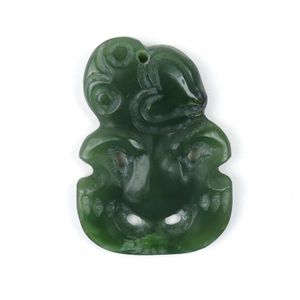
Mid/Dark Green Pounamu Hei Tiki Pendant
A 20th century carved pounamu hei tiki, heart form mouth, mid/dark green tone, length 6.2 cm. Provenance: Private Estate Collection.
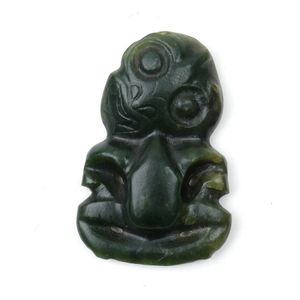
19th Century Pounamu Hei Tiki Pendant
A 19th century pounamu hei tiki, with head turned to the right and hands clasped to thighs, with small semi-concealed suspension hole to the forehead, height 6.3 cm.
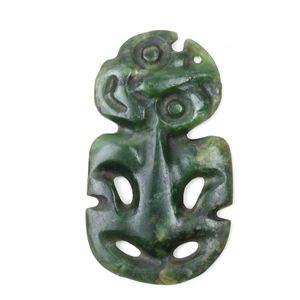
Greenstone Tiki with Hourglass Hole, Provenance Kaikai Beach
A pounamu hei tiki, with head strongly turned to the right and hands clasped to thighs, with original hourglass suspension hole broken through and another re-drilled to the forehead, variable mid-green tone with some translucence. Old label affixed to the…
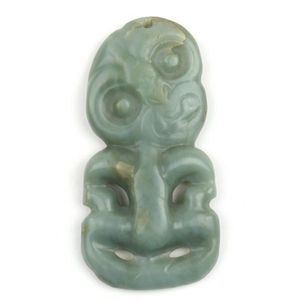
Inanga Pounamu Hei Tiki with Prestigious Color and Provenance
A good pre-European inanga pounamu hei tiki of elegant proportions and prestigious colour, chin to left shoulder, hands to thighs, hour-glass suspension hole to top, semi-concealed at the front, evidence of another hole beside. The reverse inscribed with…
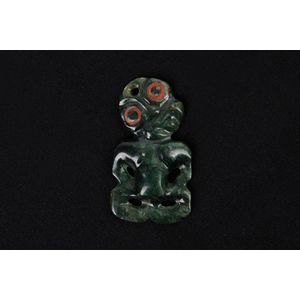
Antique Maori Pounamu Hei Tiki Pendant
19th century or earlier Maori pounamu hei tiki hour glass form suspension hole, red sealing wax eyes, face to left, hands to thighs. Rounded stomach, height 8 cm
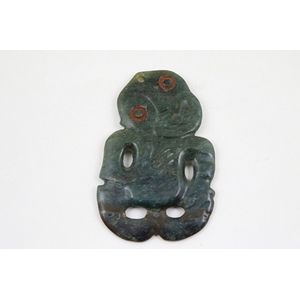
Pounamu Hei Tiki Pendant with Red Wax Inset Eyes
19th century pounamu hei tiki head inclined to left, left arm to thigh and right arm on chest with red wax inset eyes and hour glass form suspension hole (repair to legs), length 11 cm
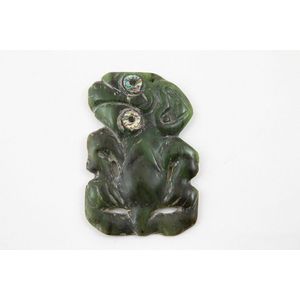
19th Century Pounamu Hei Tiki with Paua Inset Eyes
19th century pounamu hei tiki hour glass suspension hole, carved paua inset eyes, head tilted left with both arms on thighs, length 9.8 cm. Provenance: Arthur Beau Palmer collection

Antique Pounamu Hei Tiki Hourglass Pendant
19th century or earlier pounamu hei tiki hour glass form suspension hole, red sealing wax eyes. Face to right, hands to thighs. Mottled pounamu. Front of rounded form. Height 9.5 cm
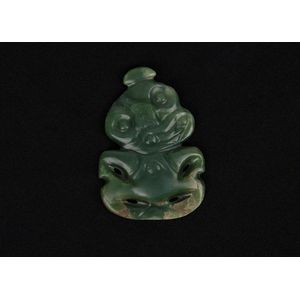
Unusual Maori Pounamu Hei Tiki with Tikitiki Top Knot
19th century or earlier Maori pounamu hei tiki very unusual form with traditional top knot (Tikitiki) to head. Face to left, hands to thighs, height 8 cm
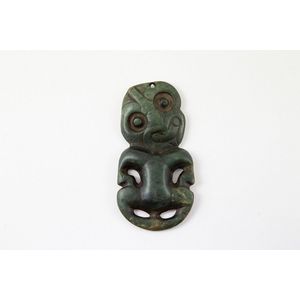
Antique Dark Greenstone Hei Tiki Pendant
Rare 19th century or earlier pounamu hei tiki dark greenstone pendant, hourglass suspension, bold features with protruding stomach, head tilted left with both arms resting on thighs, height 10.3 cm
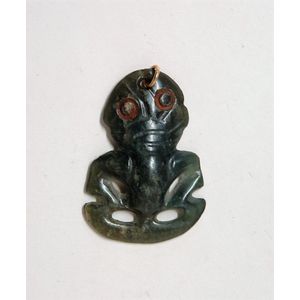
Maori Pounamu Hei Tiki Pendant with Rose Gold Ring
An old Maori pounamu (bowenite) small hei tiki, hands to thighs, the ring eyes with red wax remains, 9ct rose gold suspension ring attached. Height 6 cm.
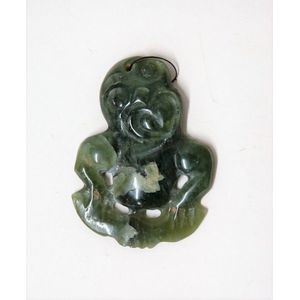
Mid-20th century Maori pounamu hei tiki pendant
An early/mid-20th century Maori pounamu hei tiki, open heart form mouth with chin to left shoulder, hands clasped to thighs, semi-translucent mid-dark green tone and in good polish. Length 7.5 cm.
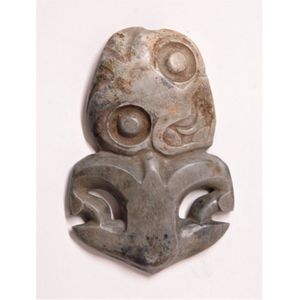
Damaged Maori Pounamu Hei Tiki with Fire Discolouration
A large pre-European Maori carved pounamu damaged hei tiki, showing evidence of fire discolouration, pale to mid-grey tone with tan inclusions, head to left shoulder, hands to thighs, the legs snapped off and absent. Note: An early 20th century note…
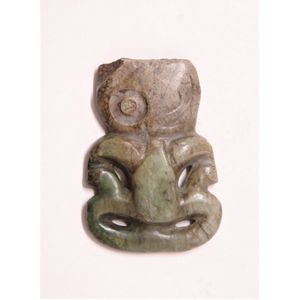
Pre-European Maori Pounamu Hei Tiki
A pre-European Maori carved pounamu hei tiki, the top of the head with old pre-European scarf and snap cut, the body of mid to pale tone with semi-translucence, the head with evidence of being in a fire. Length 9.3 cm, width 6.6 cm. Note: it is possible…
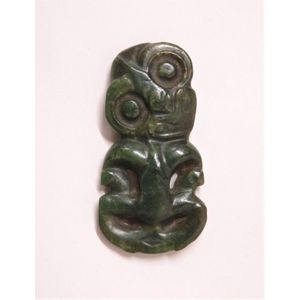
Maori Pounamu Hei Tiki Pendant
A pre-European Maori carved pounamu hei tiki, of good proportions with traditional features of head turned to left shoulder and hands clasped to thighs, single tapered hourglass drilled suspension hole, medium to dark green tone with semi-translucent pale…
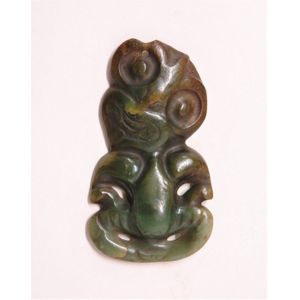
Maori Pounamu Hei Tiki Pendant
A pre-European Maori carved pounamu hei tiki, with head turned to the right shoulder, hands clasped to thighs and with single tapered hourglass drilled suspension hole, the original being through the top of the head having broken through and then modified…
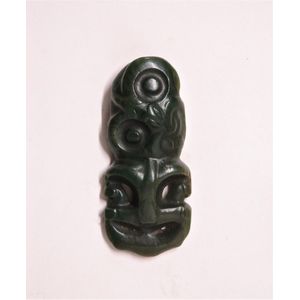
Deep Profile Maori Pounamu Hei Tiki
A good pre-European Maori carved pounamu hei tiki, of good deep profile, traditional slightly tapered form, dark green tone. Note: the depth and elegant soft carved features of this hei tiki make it an outstanding example. Length 10.8 cm, width 4.8 cm,…
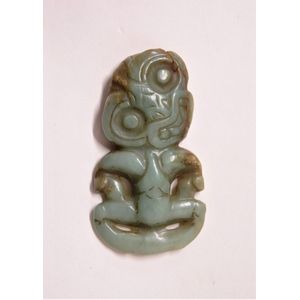
Maori Inunga Pounamu Hei Tiki Pendant
An uncommon pre-European Maori carved inunga pounamu hei tiki, good proportions and traditional form, chin to the left, hands to thighs, three tapered hourglass drilled and concealed suspension holes to the back top of head, one broken through, natural…
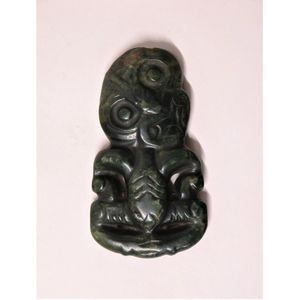
Impressive Maori Pounamu Hei Tiki with Provenance
A large and impressive pre-European Maori carved pounamu hei tiki, traditional mildly tapered form with chin to left shoulder, hands to thighs and single notch and tapered hourglass drilled and concealed suspension hole to top of head, good dark tone with…
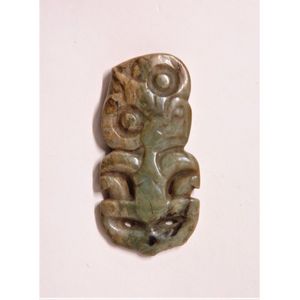
Maori Pounamu Hei Tiki Pendant
A pre-European Maori carved pounamu hei tiki, traditional form with head to left shoulder, hands to thighs, concealed notch and hourglass cut suspension hole broken through, pale to mid-green/grey tone with pale tan and dark included highlights. Length 9…
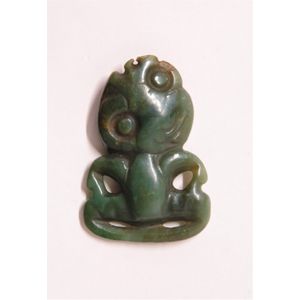
Pre-European Maori Pounamu Hei Tiki Pendant
A pre-European Maori pounamu hei tiki, traditional tapered form, head to left shoulder, hands to thighs, three early suspension holes all broken through, good mid-green tone. Length 7.7 cm, width 5.3 cm. Provenance: The Flower Family Collection.
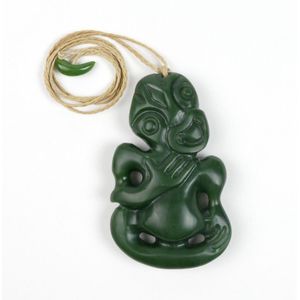
Modern Maori Pounamu Hei Tiki - 11.1cm
A modern Maori pounamu hei tiki, the right hand to chest, left to thigh, good deep profile, dark green tone. Height 11.1 cm
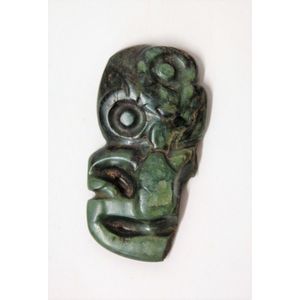
Broken Maori Pounamu Hei Tiki with Concealed Suspension Hole
A pre-European Maori pounamu hei tiki, the left arm and leg broken and absent, chin to left shoulder, concealed suspension hole to back top of head. Good dark tone with pale flecked inclusions. Length 9.3 cm. Provenance: 'Ploughed up in the 1920s by…
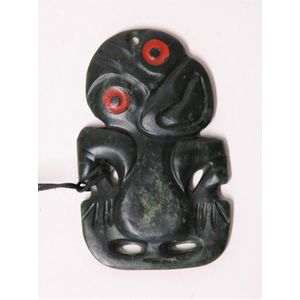
20th Century Maori Nephrite Hei Tiki Pendant
A 20th century Maori pounamu hei tiki, dark green nephrite, red sealing wax to eyes, tapered suspension hole. Not registered. Length 10.3 cm
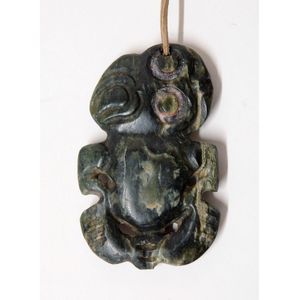
Mid 20th Century Maori Greenstone Double Sided Hei Tiki
An early/mid 20th century Maori greenstone double sided hei tiki, smooth and rounded features, dark tone with pale inclusions, slight variations to each side. Height 12.4 cm
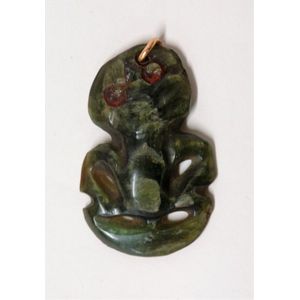
Translucent Maori Pounamu Hei Tiki Pendant
A 19th century Maori pounamu hei tiki, translucent bowenite carved with rounded stomach and rudimentary features, traces of red sealing wax to eyes. Length 6.2 cm. Gold suspension ring fitted.
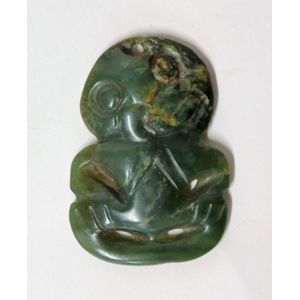
Maori Greenstone Hei Tiki Pendant
A 19th/20th century Maori greenstone hei tiki, mid/dark green semi translucent nephrite with orange/tan inclusions. Height 7.8 cm
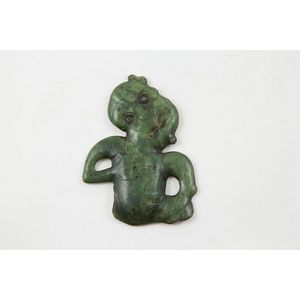
18th Century Hei Tiki Pounamu Greenstone Pendant
Superb 18th century hei tiki pounamu greenstone pendant in human form, pointed chin with hour glass suspension hole, head tilted to left, right arm to chest and left arm to thigh (legs missing), height 10 cm

Early 19th Century Hei Tiki Pounamu Pendant
Rare early 19th century hei tiki pounamu greenstone pendant in human form (referred to as the 'Fire tiki'), three suspension holes to head (two worn through), head tilted to left, right arm to mouth, left arm to thigh, length 9 cm Provenance: Jacob…
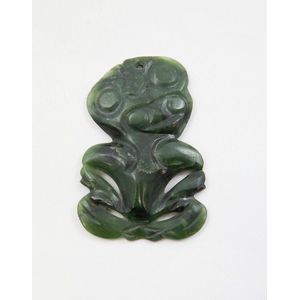
Greenstone Hei Tiki Pendant with Provenance
Hei tiki pounamu greenstone pendant in human form, head tilting to right with arms on thighs and pierced hole for suspension, length 8 cm Provenance: This hei tiki was the property of William page (died 1926) who managed 'Te Kopi' a sheep station in the…
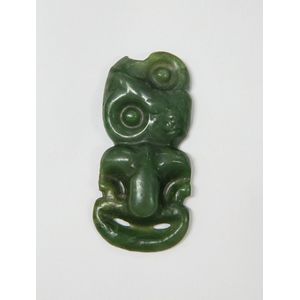
Early Hei Tiki Pounamu Greenstone Pendant in Human Form
Early hei tiki pounamu greenstone pendant in human form, head tilting to right with arms on thighs and rounded chest, hourglass suspension hole, height 8.5 cm
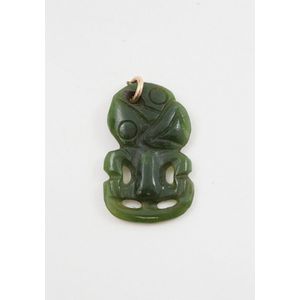
Pounamu Hei Tiki Pendant with Metal Clasp
Hei tiki pounamu greenstone pendant in human form, head inclined to right with arms on thighs, pierced hole for suspension with metal clasp attached, height 4 cm
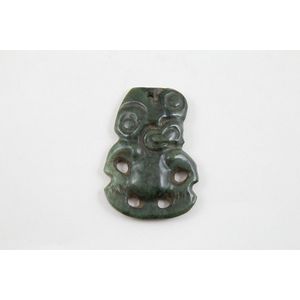
19th Century Greenstone Human Pendant with Hooked Hole
Hei tiki pounamu 19th century or earlier greenstone pendant in human form, both arms to thighs with rounded stomach and hooked suspension hole, length 8.5 cm
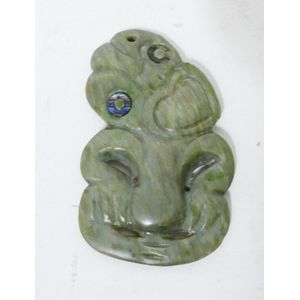
Kokopu Pounamu Hei Tiki by Mike Higgs
A pounamu hei tiki by Mike Higgs, Kokopu variety, paua shell inlaid eyes. Height 10 cm
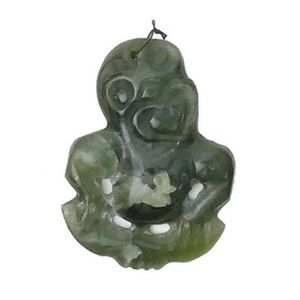
Mid-20th Century Maori Pounamu Hei Tiki Pendant
An early/mid-20th century Maori pounamu hei tiki, open heart form mouth with chin to left shoulder, hands clasped to thighs, semi-translucent mid-dark green tone and in good polish. Not registered. Height 7.5 cm
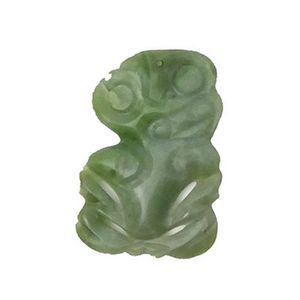
Mid-20th Century Maori Pounamu Hei Tiki Pendant
An early/mid-20th century Maori pounamu hei tiki, chin to the left shoulder, mid-green tone, tapered suspension hole. Not registered. Height 7.8 cm
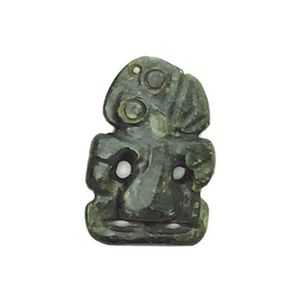
Maori Greenstone Hei Tiki Pendant
A late 19th/early 20th century Maori greenstone hei tiki, ring carved eyes, chin to left shoulder, hands clasped to the thighs, counter sunk suspension hole towards top of head, the bowenite greenstone of flecked mid/dark green tone. Height 11 cm
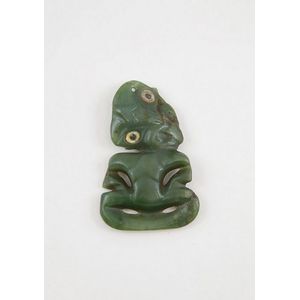
Orthodox Hei Tiki Pounamu Pendant - Early Example
Early hei tiki pounamu stunning early example in orthodox stance, well defined facial features, ribs and limbs with head tilting to the right and two pierced well worn hourglass shaped suspension holes, height 7.5 cm
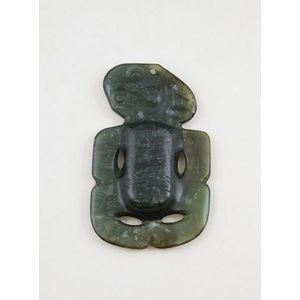
Important Hei Tiki Pounamu from Mrs. Maora Tamihana
Hei tiki pounamu large and important tiki, translucent stone with head tilting to the right, large dominant chest and arms resting to the top of the thighs, pierced hole for attachment, height 10.5 cm. Provenance: formerly owned by Mrs. Maora Tamihana of…

Asymmetrical Hei Tiki Pounamu Pendant with Suspension Hole
Hei tiki pounamu contact period, asymmetrical form with right hand to chest and left hand to thigh, suspension hole flared on reverse, height 10 cm. Provenance: Neil Darroch collection, formerly purchased Dunbar Sloane 1988
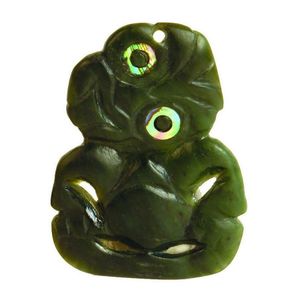
Maori Greenstone Hei Tiki Pendant
A 20th century Maori greenstone hei tiki, classical form with head turned to right shoulder, hands clasped to thighs, matt polished finish, paua shell ring inset eyes, suspension hole to top. Good dark green tone. Height 7.8 cm
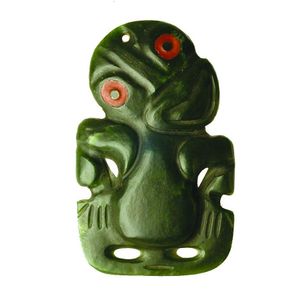
Early 20th Century Maori Greenstone Hei Tiki
A good early 20th century Maori greenstone hei tiki, even dark green tone, head turned to the left, hands clasped to thighs, red sealing wax to the ring eyes, countersigned suspension hole to top of head. 13 cm x 8 cm x 1.6 cm
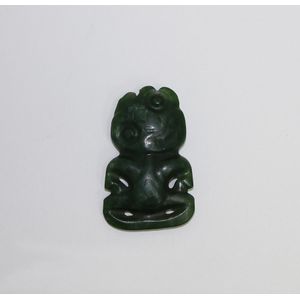
Pounamu Kawakawa Hei-Tiki with Provenance
Pounamu hei-tiki, kawakawa variety with hands to thighs and tilted head, Y17543. Provenance: Passed on by family descent from Sir George grey and Annie Matthews
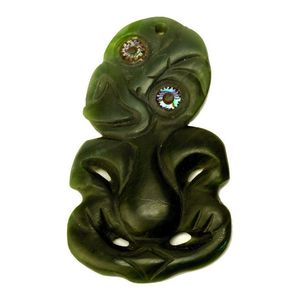
Maori Greenstone Hei Tiki with Paua Shell Inset Eyes
A 20th century Maori greenstone hei tiki, of good proportion and style, tongue extended, chin to right shoulder, hands clasped to thighs, serrated paua shell inset ring eyes, mildly counter sunk, suspension hole to top of head, good even dark green tone.…
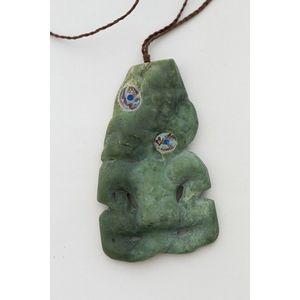
Greenstone Tiki with Paua Inset Eyes, 9.5 cm
20th century greenstone tiki paua inset eyes, 9.5 cm length, registration pending
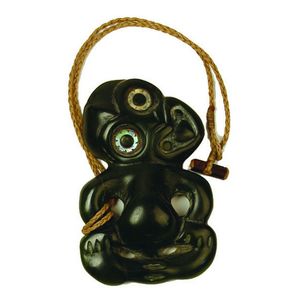
Dark Kawakawa Hei Tiki by Mike Higgs
A pounamu hei tiki, dark kawakawa variety, carved by Mike Higgs, modelled in conventional flexed stance with head inclined to left, ring eyes inset with serrated paua shell, hands modelled clasping thighs. Height 9 cm
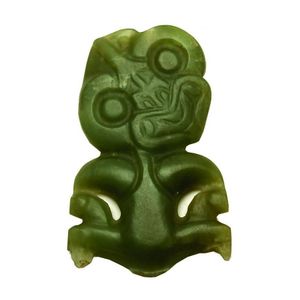
Maori Nephrite Hei Tiki Pendant, Auhunga Pounamu Variety
An old Maori nephrite hei tiki, pale Auhunga variety pounamu, modelled with head tilted with chin to left shoulder, the forehead pierced with a suspension hole and unusually with a second semi-concealed suspension hole immediately beside it, arms reach…
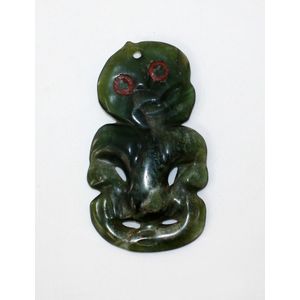
Translucent Tangiwai Hei Tiki with Red Sealing Wax Eyes
Pounamu hei tiki, translucent tangiwai (bowenite) presented in the conventional manner with hands placed to thighs. Two circular eyes with red sealing wax pierced at the forehead. Length 10 cm.

Early Hei Tiki Pounamu with Red Wax Inset Eyes
Hei Tiki Pounamu. Small early example in orthodox form, the head with red wax inset to eyes and tilting to the left and Hands resting on thighs. Pierced hand drilled hole to top of head. Height 6 cm. Width 4 cm
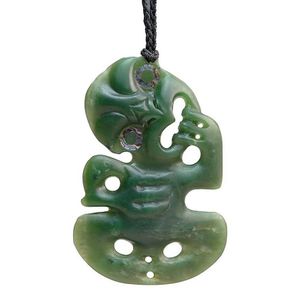
Maori Greenstone Tiki with Paua Shell Rings
A Maori greenstone tiki, New Zealand, paua shell rings around central pupils, circa 1960, 8 cm long


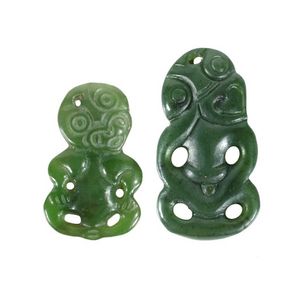
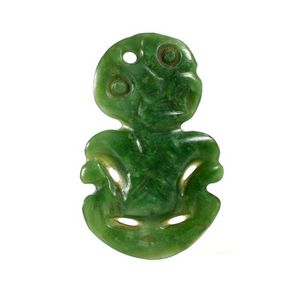
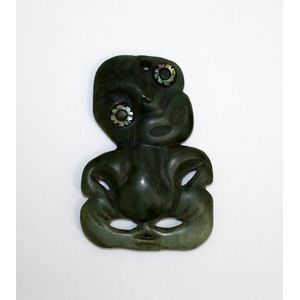
 Loading more...
Loading more...